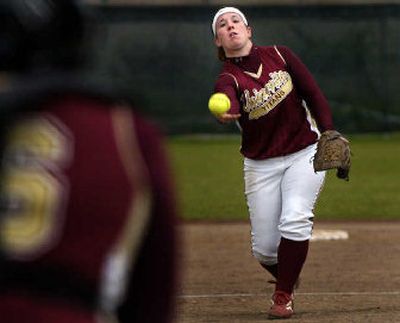Slowpitch now on fast track

In the spring, you will often find Ashley Fargher crouching behind home plate. This fall, she is spending her time on the pitcher’s mound.
Fargher, an all-Greater Spokane League softball player, is one of nine fastpitch players who turned out for slowpitch softball at University.
The Titans, Central Valley and East Valley added the sport this fall, increasing to eight the number of GSL teams in the fifth year of the league. They are playing a 14-game schedule and six advance to an end-of-season tournament in mid-October.
Fargher’s switch to pitching has been a chance to play a different position than in the spring.
“In fastpitch, (Ashley) is a great receiver,” U-Hi coach Jon Schuh said. “But with slowpitch, she gets a chance to play some middle infield and she really does a great job.”
Schuh doubles as the fastpitch and slowpitch coach at U-Hi. He said his approach to the slowpitch game is a little different, but not his coaching philosophy.
“It’s different than in the spring, I think it’s a little more laid back, maybe not quite as intense, but it’s still a sport,” Schuh said. “We still practice everyday and work hard to get better.
“People need to realize that the kids are having fun, that’s fine and dandy, but they are coming out and practicing each and every day, just like everyone else.”
The biggest difference in the slowpitch game is the offense. While fastpitch is more of a pitcher’s duel, slowpitch involves more hitting and fielding, especially for outfielders.
“An outfielder might not get any action in the spring,” Schuh said, “but they sure see a lot more action in slowpitch. A lot of balls get hit into the outfield.”
The sport, officially recognized by the GSL now that more than half of the schools have joined, is a chance for more girls to partake in fall athletics.
“Originally, slowpitch softball started with the District 81 schools that were looking to get more female participation in general,” said U-Hi athletic director Ken VanSickle, who also serves as the activities coordinator for both fastpitch and slowpitch in the GSL. “It was to get more females out for activities, sort of a Title IX issue. The Valley schools decided to add it this year for the same reason. We wanted more female participation in athletics.”
More than 30 girls turned out for the Titans and Shadle Park and Ferris have enough girls for a varsity team and two junior varsity squads. All eight teams have enough players to field a varsity and junior varsity team.
Many slowpitch participants are fastpitch players come springtime. The crossover, however, isn’t much of an advantage for the fastpitch program.
“There is definitely a different swing in fastpitch and slowpitch, so there isn’t much we can work on there.” Schuh said. “Some of them worry and get frustrated and think it will mess up their swing in fastpitch, but I tell them not to worry about that.
“It’s great to work on the defense and fielding, though.”
Some people are asking what is the point of a slowpitch softball program without a state tournament.
The league is set up so each team will play each school twice, but teams don’t have the opportunity to advance further than their double-elimination league tournament. This year, however, will mark the first time a trophy will be presented and an all-GSL team will be selected.
The point, VanSickle said, is to give girls another option in the fall.
“A lot of girls don’t have a fall sport. This gives them another opportunity to participate and play,” VanSickle said. “This adds to soccer and volleyball.”
VanSickle adds that for some, this will be a lifelong sport.
“At the end of some girls’ high school careers they won’t play fastpitch,” he said. “They will go to intramurals in college and play in the adult leagues, which are huge in Spokane.
“A lot of kids really enjoy the difference of slowpitch. In fastpitch, the pitchers dominate the league. In slowpitch, there is a lot more hitting so there is a lot of action.”
The program seems to be nothing but a positive in VanSickle’s eyes. Schuh agrees.
“It is important that kids get the high school experience. They learn about a team game and doing things as a team,” Schuh said. It’s neat that you’re constantly involved in the game and get a chance to do something different.”